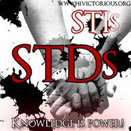
STIs and HIV: The tie and why it matters
By Tamara E. Holmes
It’s no secret that connections exist between HIV and other sexually transmitted infections (STIs), but researchers are pushing for more coordination to reduce the incidence of all such conditions.
Two sessions at AIDS 2012 looked at the correlations between HIV and other STIs. One, called “Dangerous Liaisons: HIV and Sexually Transmitted Infections,” highlighted research showing that many people diagnosed with other STIs are often later diagnosed or con-currently diagnosed with HIV. In fact, according to the Centers for Disease Control and Prevention (CDC), people infected with an STI are two to five times more likely to become infected with HIV after exposure to the virus than people who are not infected by another STI. The other session, “Enhancing STI (Sexually Transmitted Infection) Services for HIV Prevention,” looked at the value of screening people diagnosed with any STIs for HIV and targeting prevention messages to-ward that group.
Breaking Down the Link
The relationship between HIV and other STIs is complex because it is both biological and behavioral. Certain STIs, such as syphilis, herpes and chanroid, create genital ulcers, which cause breaks in the lining of the genital tract. Those breaks can then become entry points for HIV. STIs such as chlamydia, gonorrhea and trichomoniasis can also create inflammation, which increases the concentration of cells in genital secretions that the virus can attach to.
Not only does infection with these STIs make it easier to acquire HIV, but they also make it easier to transmit it. Ac-cording to the CDC, studies have shown that people who are living with HIV/AIDS and also are infected with other STIs are more likely to transmit HIV through their genital secretions.
Researchers at the AIDS 2012 sessions also pointed out that similar behaviors can lead a person to acquire HIV and other STIs. For example, having sex without a condom, frequently changing sexual partners or having concurrent relationships—more than one sexual relationship at the same time—increases a person’s risk of acquiring STIs, including HIV.
Lessons to be Learned
So why is it important to understand the association between HIV and other STIs? STIs are a major health concern in the Black community. More than half of reported primary- and secondary-syphilis cases (those occurring at the earliest and most infectious period of the disease) occur among Black Americans. This means that Black Americans are particularly vulnerable to STIs simply because a higher percentage of people in the Black community are already living with STIs. However, it’s important to note that data could be skewed because different states have different reporting requirements for certain STIs. That means private physicians may not have to report specific STIs in some states, whereas public health centers—where many Black Americans get their care—must report data as part of program requirements.
HIV-prevention messages should be targeted toward communities that have high levels of STI rates, conference researchers said. HIV testing can also be increased in such communities because people with other STIs are at an increased risk of acquiring HIV. This makes using condoms even more important for those who don’t know their partner’s HIV status. Treatment for STIs can decrease a person’s likelihood of transmitting HIV.
People living with HIV/AIDS should also be careful not to become infected with other STIs. Some HIV-positive individuals forsake condoms when they have sex with other people with HIV. However, this leaves you vulnerable to other STIs, conference participants said, unless you and your partner have both tested negative for them.
The symptoms for STIs vary. Among them are itching, discharge, lumps, sores and pain in the genital area. However, many STIs, such as chlamydia and gonorrhea, don’t always have symptoms, so the only way you’d know you were infected would be to get tested by a healthcare provider.
So what can you do to safe-guard your health? Luckily, the same behaviors that will keep you from acquiring HIV will keep you from acquiring other STIs.
* Use condoms with any-one you don’t know to be STI-negative.
* When you get tested for HIV, get tested for other STIs, too.
* When you open a dialogue with a new partner about HIV, add other STIs to the conversation.
* If you suspect that you have an STI, get tested and treated as soon as possible.
Tamara E. Holmes is a freelance journalist who writes frequently about health and wellness.
